Papers by Claude Alabouvette

Soilborne diseases are caused by pathogenic agents constituting single populations among complex ... more Soilborne diseases are caused by pathogenic agents constituting single populations among complex communities of microorganisms. These populations are interacting and regulating their densities and activities, also modulated by the a-biotic environment. Cultural practices such as the application of organic amendments, rotation of crops, intercropping, bio-disinfestation, solarisation, and tillage practices influence the balance between functional groups in soils. Some of these cultural practices, alone or in combination have the capacity to enhance disease suppression but their efficacy depends on the resident microflora of the soil and on the specific ecological requirements of the pathogens. More detailed investigation of the biologically complex system and improvements of the presently available methods are necessary to improve practices in order to manage this microbial potential in an economically and feasible manner.
Progress in Biological Control, 2006
... Moreover solid state fermentation enables to utilise different types of agricultural waste pr... more ... Moreover solid state fermentation enables to utilise different types of agricultural waste products that are ... control method is to choose a method of application that will enable to deliver ... but also most of the beneficial soil micro-organisms, leading to an unbalanced equilibrium in ...

Plant Pathology
Knowing that actin microfilaments play a key role in the mobilization of the defence-associated c... more Knowing that actin microfilaments play a key role in the mobilization of the defence-associated cellular responses, the aim of this study was to compare changes affecting the actin cytoskeleton in tomato cells after inoculation with germinated microconidia of a bio-control (Fo47, Fom24) or a pathogenic (Fol8) strain of F. oxysporum. Actin microfilaments were observed by labelling with TRITC-phalloidin combined with fluorescence microscopy. Results showed that only tenuous changes in the actin cytoskeleton architecture occurred after inoculation with the bio-control strains whereas the actin cytoskeleton was significantly altered after inoculation with the pathogenic one. In the two types of interaction, cell death occurs and can be considered as one key component of cell defence responses. A pharmacological approach using cytochalasins was chosen to determine if the inhibition of actin polymerization differently affects the kinetics of tomato cell death. Data showed that cytochalasi...

The most visible impact of human activities on biodiversity concerns species which are part of ou... more The most visible impact of human activities on biodiversity concerns species which are part of our cultural heritage but a huge part of the species are still undescribed, mainly those in the ocean, in extreme environments and of course in the soil where the damage caused by anthropogenic activities are unknown. Although some estimation can be proposed, they are all considered as underevaluations of the putative number of taxa that could be present on the planet Earth. Despite it is not yet known how, this biodiversity contributes to different services through the functioning of ecosystems, and thus influences the sustainability of these ecosystems. At a smaller scale, the one we can approach in the frame of this workshop, it is clear that biodiversity is shaped by farmed ecosystems but in return, the organisms building up the community contribute directly to the farmed ecosystems, via the regulation of parasites and diseases of crops and the contribution to the fertility of the soil...
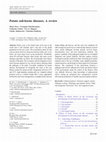
Potato crop is the fourth main food crop in the world and it will certainly feed a big part of th... more Potato crop is the fourth main food crop in the world and it will certainly feed a big part of the global population in the next years. The economical outlets for this crop are great; however, numerous diseases either soil-or airborne can cause huge losses in the production. Worldwide, about 40 soil-borne diseases affect potato and cause severe damages especially on tubers, the economically most important part of the plant. The occurrence and development of soilborne diseases depend on very diverse factors affecting either the pathogen or the plant. Favorable conditions for potato diseases development are frequently the same as the conditions needed for potato growth: temperature between 10°C and 25°C, high humidity, medium pH, etc. Adapted cultural practices such as a rotation longer than 4 years, appropriate fertilization and water management, an adapted delay between haulm killing and harvest, and dry and cool conditions for tuber storage are good ways to control potato diseases. In most cases, potato pathogens develop specific survival forms, dissemination ways and host penetration methods. The genetic variability of the pathogens implies the use of adapted diagnostic and control methods. Decision support systems developed to predict yield losses allow choosing good control methods such as the use of healthy seeds, adapted pesticides, cultural practices, and biological control agents for each potato disease. The complexity of the interactions between a pathogen and its host, influenced by biotic and abiotic factors of the environment, make the control of the diseases often very difficult. However, deep knowledge of pathosystems allows setting up integrated pest management systems allowing the production of healthy and good quality potatoes.
Pesticide Science, 1993
Studies of soils suppressive to fusarium wilts have indicated that the phenomenon is fundamentall... more Studies of soils suppressive to fusarium wilts have indicated that the phenomenon is fundamentally microbiological in nature, resulting from complex microbial interactions between the pathogen and all, or a part of, the saprophytic microflora.
NATO Security through Science Series, 2007
Soil-borne strains of F. oxysporum are involved in the mechanisms of soil suppressiveness to Fusa... more Soil-borne strains of F. oxysporum are involved in the mechanisms of soil suppressiveness to Fusarium wilts, and many attempts have been made to use strains of Fusarium oxysporum to control Fusarium diseases. The modes of action of the protective strains are diverse; they include direct antagonism, competition for nutrients, and indirect antagonism through induced resistance of the plant. The use

Agronomy for Sustainable Development, 2011
Potato crop is the fourth main food crop in the world and it will certainly feed a big part of th... more Potato crop is the fourth main food crop in the world and it will certainly feed a big part of the global population in the next years. The economical outlets for this crop are great; however, numerous diseases either soil-or airborne can cause huge losses in the production. Worldwide, about 40 soil-borne diseases affect potato and cause severe damages especially on tubers, the economically most important part of the plant. The occurrence and development of soilborne diseases depend on very diverse factors affecting either the pathogen or the plant. Favorable conditions for potato diseases development are frequently the same as the conditions needed for potato growth: temperature between 10°C and 25°C, high humidity, medium pH, etc. Adapted cultural practices such as a rotation longer than 4 years, appropriate fertilization and water management, an adapted delay between haulm killing and harvest, and dry and cool conditions for tuber storage are good ways to control potato diseases. In most cases, potato pathogens develop specific survival forms, dissemination ways and host penetration methods. The genetic variability of the pathogens implies the use of adapted diagnostic and control methods. Decision support systems developed to predict yield losses allow choosing good control methods such as the use of healthy seeds, adapted pesticides, cultural practices, and biological control agents for each potato disease. The complexity of the interactions between a pathogen and its host, influenced by biotic and abiotic factors of the environment, make the control of the diseases often very difficult. However, deep knowledge of pathosystems allows setting up integrated pest management systems allowing the production of healthy and good quality potatoes.
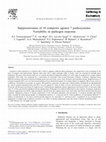
Soil Biology and Biochemistry, 2006
Compost is often reported as a substrate that is able to suppress soilborne plant pathogens, but ... more Compost is often reported as a substrate that is able to suppress soilborne plant pathogens, but suppression varies according to the type of compost and pathosystem. Reports often deal with a single pathogen while in reality crops are attacked by multiple plant pathogens. The goal of the present study was to evaluate the disease suppression ability of a wide range of composts for a range of plant pathogens. This study was conducted by a consortium of researchers from several European countries. Composts originated from different countries and source materials including green and yard waste, straw, bark, biowaste and municipal sewage. Suppressiveness of compost-amended (20% vol./vol.) peat-based potting soil was determined against Verticillium dahliae on eggplant, Rhizoctonia solani on cauliflower, Phytophthora nicotianae on tomato, Phytophthora cinnamomi on lupin and Cylindrocladium spathiphylli on Spathiphyllum sp., and of compost-amended loamy soil (20% vol./vol.) against R. solani on Pinus sylvestris and Fusarium oxysporum f. sp. lini on flax. From the 120 bioassays involving 18 composts and 7 pathosystems, significant disease suppression was found in 54% of the cases while only 3% of the cases showed significant disease enhancement. Pathogens were affected differently by the composts. In general, prediction of disease suppression was better when parameters derived from the compost mixes were used rather than those derived from the pure composts. Regression analyses of disease suppression of the individual pathogens with parameters of compost-amended peat-based mixes revealed the following groupings: (1) competition-sensitive: F. oxysporum and R. solani/cauliflower; (2) rhizosphere-affected: V. dahliae; (3) pH-related: P. nicotianae; and (4) specific/unknown: R. solani/pine, P. cinnamomi and C. spathiphylli. It was concluded that application of compost has in general a positive or no effect on disease suppression, and only rarely a disease stimulating effect. r
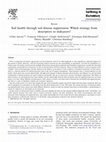
Soil Biology and Biochemistry, 2007
Soil is a component of primary importance in crop production, even if it is often neglected, or o... more Soil is a component of primary importance in crop production, even if it is often neglected, or only regarded as a physical support for the growth of plants. However, with the increasing societal concerns for the sustainability of agriculture, soil must be considered as a living system. Its quality results from the multiple interactions among physicochemical and biological components, notably the microbial communities, primordial for soil function. Crops are threatened by soil-borne diseases. These are often difficult to control, because of the ''hidden'' status of the pathogens and also because of the absence, noxiousness or lack of efficacy of chemical treatments. In this context, there is a renewed interest for cultural practices such as the use of organic amendments. These practices have a strong influence on soil health, which takes into account plant health, through both changes of physicochemical characteristics and influence on soil microbial communities. Cultural practices are used to improve soil health, and can, in some cases, increase soil disease suppression. The effects of these practices on soil properties have been studied, but the relationship between these properties and soil suppressiveness has not been always very clear. Many different soil descriptors, either abiotic or biotic, have been used to describe the soil health and suppressiveness, but there is a lack of identified, reliable and consistent indicators.

Soil Biology and Biochemistry, 1995
To assess the influence of clay minerals and soil pH on the degree of soil suppressiveness, 25% (... more To assess the influence of clay minerals and soil pH on the degree of soil suppressiveness, 25% (w/w) kaolinit~:, Ca-montmorillonite and illite were added to a fusarium wilt-conducive soil (loam, pH 4.0) and 3 values of soil pH (pH 4.0, 5.0 and 7.0) were obtained by liming. The soil-clay mixtures were sown with wheat; after 6 and 30 weeks, respectively, of wheat growth, soil samples were taken. Their levels of suppressiveness to fusarium wilt of flax were assessed and several characteristics of the soil microflora were determined. After 6 weeks of wheat growth, the addition of either montmorillonite or illite significantly increased the degree of soil suppressiveness to fusarium wilts, but only at pH 7. Neither liming alone nor the addition of kaolinite, with or without lime, had an effect. After another 6 months of wheat growth, the level of suppressiveness had increased in all amended soils. The strongest effect was obtained when kaolinite, montmorillonite or illite was added and the soil pH was raised to 7. The level of soil suppressiveness was correlated with physicochemical characteristics (texture, pH, exchangeable Ca and Mg and EDTA-extractable iron), and biological characteristics (population densities of bacteria, fluorescent pseudomonads and autochtonous Fusarium oxysporum, and the induced respiration of the soil microflora after glucose supply). The results are discussed in relation to the common hypotheses related to factors and mechanisms involved in soil suppressiveness to fusarium wilts.
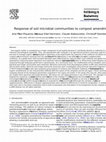
Soil Biology and Biochemistry, 2006
Soil organic matter is considered as a major component of soil quality because it contributes dir... more Soil organic matter is considered as a major component of soil quality because it contributes directly or indirectly to many physical, chemical and biological properties. Thus, soil amendment with composts is an agricultural practice commonly used to improve soil quality and also to manage organic wastes. We evaluated in laboratory scale experiments the response of the soilborne microflora to the newly created soil environments resulting from the addition of three different composts in two different agricultural soils under controlled conditions. At a global level, total microbial densities were determined by classical plate count methods and global microbial activities were assessed by measuring basal respiration and substrate induced respiration (SIR). Soil suppressiveness to Rhizoctonia solani diseases was measured through bioassays performed in greenhouses. At a community level, the modifications of the metabolic and molecular structures of bacterial and fungal communities were assessed. Bacterial community level physiological profiles (CLPP) were determined using Biologe GN microtiter plates. Bacterial and fungal community structures were investigated using terminal restriction fragment length polymorphism (T-RFLP) fingerprinting. Data sets were analyzed using analysis of variance and ordination methods of multivariate data. The impact of organic amendments on soil characteristics differed with the nature of the composts and the soil types. French and English spent mushroom composts altered all the biological parameters evaluated in the clayey soil and/or in the sandy silty clay soil, while green waste compost did not modify either bacterial and fungal densities, SIR values nor soil suppressiveness in any of the soils. The changes in bacterial T-RFLP fingerprints caused by compost amendments were not related to the changes in CLPP, suggesting the functional redundancy of soil microorganisms. Assessing the density, the activity and the structure of the soil microflora allowed us not only to detect the impact of compost amendment on soil microorganisms, but also to evaluate its effect at a functional level through the variation of soil disease suppressiveness. Differences in disease suppressiveness were related to differences in chemical composition, in availability of nutrients at short term and in microbial composition due to both incorporation and stimulation of microorganisms by the compost amendments. q

PLoS Pathogens, 2009
Dimorphism or morphogenic conversion is exploited by several pathogenic fungi and is required for... more Dimorphism or morphogenic conversion is exploited by several pathogenic fungi and is required for tissue invasion and/or survival in the host. We have identified a homolog of a master regulator of this morphological switch in the plant pathogenic fungus Fusarium oxysporum f. sp. lycopersici. This non-dimorphic fungus causes vascular wilt disease in tomato by penetrating the plant roots and colonizing the vascular tissue. Gene knock-out and complementation studies established that the gene for this putative regulator, SGE1 (SIX Gene Expression 1), is essential for pathogenicity. In addition, microscopic analysis using fluorescent proteins revealed that Sge1 is localized in the nucleus, is not required for root colonization and penetration, but is required for parasitic growth. Furthermore, Sge1 is required for expression of genes encoding effectors that are secreted during infection. We propose that Sge1 is required in F. oxysporum and other non-dimorphic (plant) pathogenic fungi for parasitic growth.
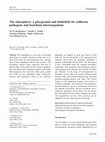
Plant and Soil, 2009
The rhizosphere is a hot spot of microbial interactions as exudates released by plant roots are a... more The rhizosphere is a hot spot of microbial interactions as exudates released by plant roots are a main food source for microorganisms and a driving force of their population density and activities. The rhizosphere harbors many organisms that have a neutral effect on the plant, but also attracts organisms that exert deleterious or beneficial effects on the plant. Microorganisms that adversely affect plant growth and health are the pathogenic fungi, oomycetes, bacteria and nematodes. Most of the soilborne pathogens are adapted to grow and survive in the bulk soil, but the rhizosphere is the playground and infection court where the pathogen establishes a parasitic relationship with the plant. The rhizosphere is also a battlefield where the complex rhizosphere community, both microflora and microfauna, interact with pathogens and influence the outcome of pathogen infection. A wide range of microorganisms are beneficial to the plant and include nitrogen-fixing bacteria, endo-and ectomycorrhizal fungi, and plant growth-promoting bacteria and fungi. This review focuses on the population dynamics and activity of soilborne pathogens and beneficial microorganisms. Specific attention is given to mechanisms involved in the tripartite interactions between beneficial microorganisms, pathogens and the plant. We also discuss how agricultural practices affect pathogen and antagonist populations and how these practices can be adopted to promote plant growth and health.
Phytopathology, 2002
Trouvelot, S., Olivain, C., Recorbet, G., Migheli, Q., and Alabouvette, C. 2002. Recovery of Fusa... more Trouvelot, S., Olivain, C., Recorbet, G., Migheli, Q., and Alabouvette, C. 2002. Recovery of Fusarium oxysporum Fo47 mutants affected in their biocontrol activity after transposition of the Fot1 element. Phytopathology 92:936-945.
Phytoparasitica, 2000
An alternative to chemical control of plant diseases is biological control based on application o... more An alternative to chemical control of plant diseases is biological control based on application of antagonistic micro-organisms. It is often stated that biological control would be safer tbr the environment than chemical control. However, one can argue that, on the contrary, releasing high inoculum densities of micro-organisms in order to modify the microbial balance could be dangerous for the environment. In fact, there is no general answer to this concern; it obviously depends on the biological control method proposed. If the method consists in mimicking natural control that exists in certain situations, it can be regarded as safe. For example, biological control of fusarium wilts based on applications of non-pathogenic strains of Fusarium oxysporum, associated with strains of Pseudomonas fluorescens, tends to reproduce in conducive soils the mechanisms by
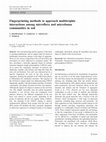
Biology and Fertility of Soils - BIOL FERT SOILS, 2008
The soil functioning and the response of the biota to external perturbations such as organic inpu... more The soil functioning and the response of the biota to external perturbations such as organic input are based on multitrophic interactions among a wide range of organisms. However, the various components of the soil microflora and microfauna are rarely addressed in ecological studies. We have developed a molecular approach based on terminal restriction fragment length polymorphism (T-RFLP) analysis to assess the community structures of protozoa and nematodes, together with bacteria and fungi that share the same soil environment. Two soils were characterized by a specific fingerprint for each of the four groups of organisms, showing the potential of all T-RFLP procedures to differentiate the community structures. The response of the soil biota to organic inputs was addressed using T-RFLP fingerprints together with physiological profiles of bacteria communities and global microbial activities and densities. Although the impact of compost or manure on the soil biota was only slightly no...
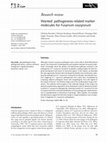
New Phytologist, 2003
Although Fusarium oxysporum pathogens cause severe wilts in about 80 botanical species, the mecha... more Although Fusarium oxysporum pathogens cause severe wilts in about 80 botanical species, the mechanisms of pathogenicity and symptom induction are poorly understood. Knowledge about the genetic and biochemical pathways involved in the pathogenesis of F. oxysporum would be invaluable in getting targets for both fungicide development and search for biocontrol agents. In this respect, we described the main approaches that have been developed to identify some mechanisms underlying the pathogenesis of F. oxysporum . During the last decades, the potential functions triggering of F. oysporum pathogenicity have mainly been investigated by comparing soilborne pathogenic strains with nonpathogenic ones with regards to the analysis of the pre-and infection stages and of the resulting plant-fungus interactions. The relatively recent progress in the molecular biology of this fungus has allowed complementary approaches to be developed in order to identify key factors involved in F. oxysporum pathogenicity. Screening mutants of F. oxysporum for loss of virulence led to the successful identification of some pathogenesis-related factors, such as hydrophobicity or attachment of germlings. Taken together, the strategies described above support the idea that changes in fungal metabolism is also of importance in triggering of F. oxysporum pathogenesis. 159 : 73 -92

Uploads
Papers by Claude Alabouvette